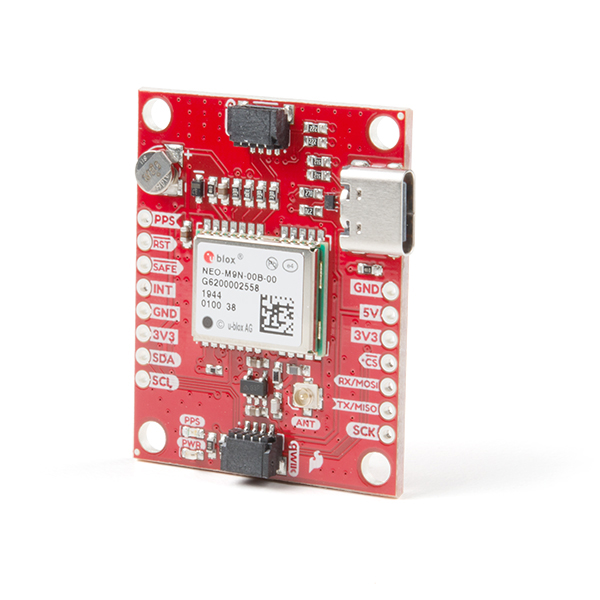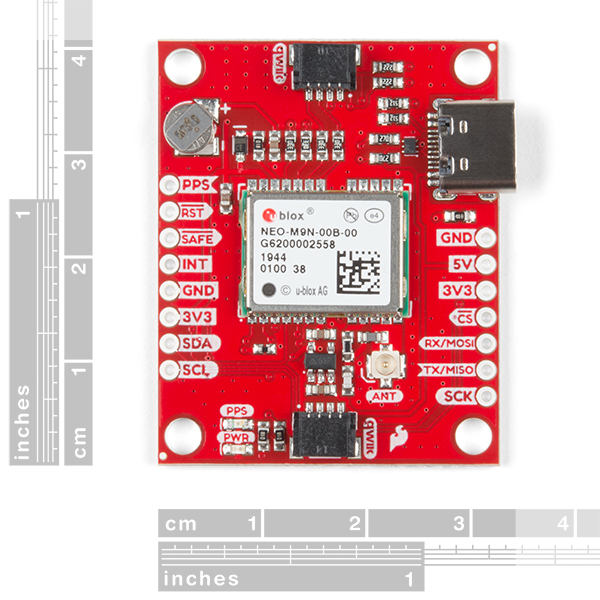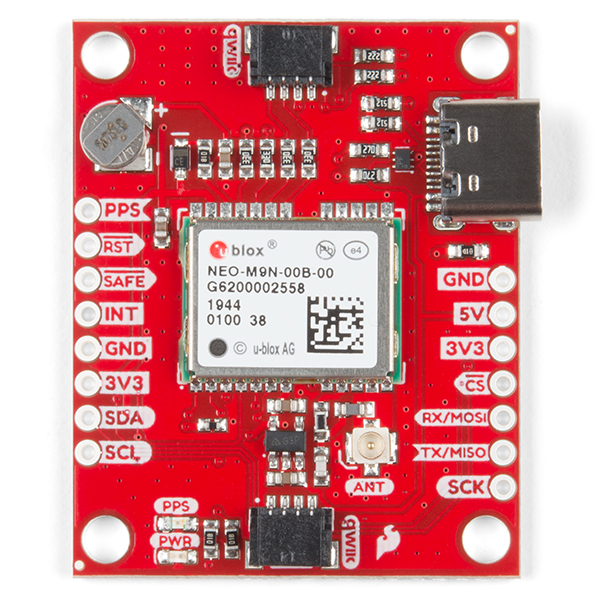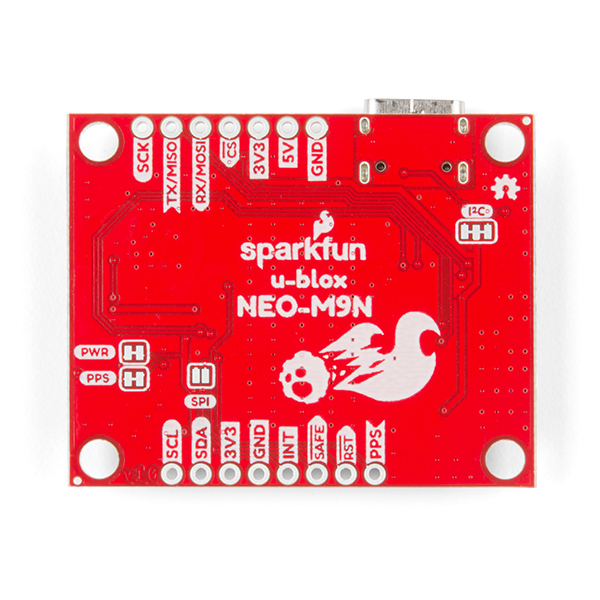SparkFun GPS Breakout - NEO-M9N, U.FL (Qwiic)
The SparkFun NEO-M9N GPS Breakout is a high quality GPS board with equally impressive configuration options. The NEO-M9N module is a 92-channel u-blox M9 engine GNSS receiver, meaning it can receive signals from the GPS, GLONASS, Galileo, and BeiDou constellations with ~1.5 meter accuracy. This breakout supports concurrent reception of four GNSS. This maximizes position accuracy in challenging conditions, increasing precision and decreases lock time; and thanks to the onboard rechargeable battery, you'll have backup power enabling the GPS to get a hot lock within seconds! Additionally, this u-blox receiver supports I2C (u-blox calls this Display Data Channel) which made it perfect for the Qwiic compatibility so we don't have to use up our precious UART ports. Utilizing our handy Qwiic system, no soldering is required to connect it to the rest of your system. However, we still have broken out 0.1"-spaced pins in case you prefer to use a breadboard.
The NEO-M9N module detects jamming and spoofing events and can reports them to the host, so that the system can react to such events. A SAW (Surface Acoustic Wave) filter combined with an LNA (Low Noise Amplifier) in the RF path is integrated into the NEO-M9N module which allows normal operation even under strong RF interferences.
U-blox based GPS products are configurable using the popular, but dense, windows program called u-center. Plenty of different functions can be configured on the NEO-M9N: baud rates, update rates, geofencing, spoofing detection, external interrupts, SBAS/D-GPS, etc. All of this can be done within the SparkFun Arduino Library!
The SparkFun NEO-M9N GPS Breakout is also equipped with an on-board rechargeable battery that provides power to the RTC on the NEO-M9N. This reduces the time-to-first fix from a cold start (~24s) to a hot start (~2s). The battery will maintain RTC and GNSS orbit data without being connected to power for plenty of time.
This product requires an antenna: Be sure to check out the related products/hookup accessories and pick a suitable U.FL antenna for your project.
The SparkFun Qwiic Connect System is an ecosystem of I2C sensors, actuators, shields and cables that make prototyping faster and less prone to error. All Qwiic-enabled boards use a common 1mm pitch, 4-pin JST connector. This reduces the amount of required PCB space, and polarized connections mean you can’t hook it up wrong.
The NEO-M9N GPS Breakout can also be automatically detected, scanned, configured, and logged using the OpenLog Artemis datalogger system. No programming, soldering, or setup required!
- Integrated U.FL connector for use with antenna of your choice
- 92-Channel GNSS Receiver
- 1.5m Horizontal Accuracy
- 25Hz Max Update Rate (4 concurrent GNSS)
- Time-To-First-Fix:
- Cold: 24s
- Hot: 2s
- Max Altitude: 80,000m
- Max G: ≤4
- Max Velocity: 500m/s
- Velocity Accuracy: 0.05m/s
- Heading Accuracy: 0.3 degrees
- Time Pulse Accuracy: 30ns
- 3.3V VCC and I/O
- Current Consumption: ~31mA Tracking GPS+GLONASS
- Software Configurable
- Geofencing
- Odometer
- Spoofing Detection
- External Interrupt
- Pin Control
- Low Power Mode
- Many others!
- Supports NMEA, UBX, and RTCM protocols over UART or I2C interfaces
SparkFun GPS Breakout - NEO-M9N, U.FL (Qwiic) Product Help and Resources
Getting Started with U-Center for u-blox
September 13, 2018
Learn the tips and tricks to use the u-blox software tool to configure your GPS receiver.
SparkFun GPS NEO-M9N Hookup Guide
December 19, 2019
The u-blox NEO-M9N is a powerful GPS unit that comes with a chip antenna, SMA connector, and u.FL connector. We will quickly get you set up using the Qwiic ecosystem and Arduino so that you can start reading the output!
How to Upgrade Firmware of a u-blox GNSS Receiver
March 26, 2021
A few steps and you'll upgrade to the latest features on a u-blox GNSS receiver.
Core Skill: Programming
If a board needs code or communicates somehow, you're going to need to know how to program or interface with it. The programming skill is all about communication and code.
Skill Level: Competent - The toolchain for programming is a bit more complex and will examples may not be explicitly provided for you. You will be required to have a fundamental knowledge of programming and be required to provide your own code. You may need to modify existing libraries or code to work with your specific hardware. Sensor and hardware interfaces will be SPI or I2C.
See all skill levels
Core Skill: Electrical Prototyping
If it requires power, you need to know how much, what all the pins do, and how to hook it up. You may need to reference datasheets, schematics, and know the ins and outs of electronics.
Skill Level: Rookie - You may be required to know a bit more about the component, such as orientation, or how to hook it up, in addition to power requirements. You will need to understand polarized components.
See all skill levels
Comments
Looking for answers to technical questions?
We welcome your comments and suggestions below. However, if you are looking for solutions to technical questions please see our Technical Assistance page.
Customer Reviews
4 out of 5
Based on 5 ratings:
The latest multi GNSS from u-blox
Works great with an external antenna. This board delivers the most performance from the latest u-blox chip. Especially useful for vehicles application as the many satellites received make it suitable for navigation in difficult environments such as urban canyons. The Sparkfun tutorial, u-center and library are very easy to use.
Don’t forget to buy a suitable antenna.
Not having much luck with this board
Trying to get board to respond over IIC for NMEA message. Have the integration manual but not able to figure out the exact sequence of bytes to make it work. I know the bus works because it responds with hex address 0x42 per schematic. Right now I am not happy as I need to bus 20 more boards but right now it wont be this one. Antenna connection is just awful as I purchased the small UFL antenna ffor it. I know it connected to satellite as the BLUE LED is flashing.
Sorry to hear you are running into issues with this product. Send us an Email and we can assist you with your device or get you a replacement if applicable: support@sparkfun.com
Super fast cold-start
Cold-start is about 2s indoor near a window with a simple flexible molex u.fl antenna. USB-C a nice bonus to get serial output on my mac laptop. U-center "easy" to use with some experience. Only suggestion for improvement is a smaller board ... quite a bit of white space.
Very good performance
NEO-M9N (U.FL) breakout board has very good performance as portable GNSS receiver.





what is the part number for the voltage regulator on this PCB?